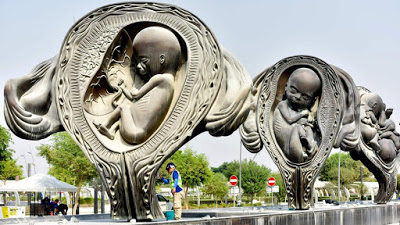These 14 giant uterus sculptures show you the journey from conception to birth
 |
| SHANNON CONNELLAN NOV 19, 2018 |
Want to know what the uterus looks like in the various stages before a baby is born? Yeah, you do.
British artist Damien Hirst has officially unveiled 14 colossal bronze uterus sculptures outside a hospital in Qatar, graphically documenting the stages from conception to birth.
The gigantic bronze work is called The Miraculous Journey, and begins with the fertilization of an egg, depicts various stages of a fetus growing inside the uterus, and culminates in a 46-foot baby.
Each sculpture ranges from 5 to 11 metres (16 to 36 feet) in height and the whole thing weighs a massive 216 metric tonnes.
Sitting in Qatar’s capital of Doha, the work has been installed outside the newish $8 billion Sidra Medical and Research Centre, which AFP reports has quite the contemporary art collection, including an installation by fellow British artist Tracey Emin.
Hirst’s sculptures were commissioned for $20 million by art enthusiast and chairwoman of the Qatar Museums Authority, Sheikha al Mayassa Hamad bin Khalifa al-Thani (the sister of Qatar’s ruling Emir Tamim bin Hamad Al Thani), as part of a set of cultural initiatives that “aim to redress the traditional boundaries between eastern and western art in the Middle East.”
The sculptures were actually unveiled in October 2013, but were reportedly covered up until the big reveal in October 2018.

The uterus, 14 ways.
IMAGE: STRINGER/AFP/GETTY IMAGES
The official reason, reports AFP, was to protect the sculptures against damage from hospital construction, but the news wire noted that the statue had seen its fair share of social media discussion around its appearance.
“We do not expect everyone to like them, we do not expect everyone to understand them,” Layla Ibrahim Bacha, arts specialist at the government-funded Qatar Foundation, told AFP.
“That’s why they are here to create an element of debate and reflection. We believe that (the work) reflects Sidra’s mission to care for the health of women and babies.”

Snug.
IMAGE: STRINGER/AFP/GETTY IMAGES
Sheikha al Mayassa Hamad bin Khalifa al-Thani, who commissioned the work, told The New York Times in 2013, when it was first announced, that she didn’t consider the work controversial.
“To have something like this is less daring than having a lot of nudity,” she said. “There is a verse in the Koran about the miracle of birth. It is not against our culture or our religion.”

Behold, the journey from conception to birth, Seriously, you won’t be able to miss it, Doha.
IMAGE: STRINGER/AFP/GETTY IMAGES
Hirst said in his 2013 release that the work came from “a desire to create something monumental, whilst essentially human.”
“Ultimately, the journey a baby goes through before birth is bigger than anything it will experience in its human life,” he said. “I hope the sculpture will instill in the viewer a sense of awe and wonder at this extraordinary human process.”
Like it or not, patients won’t miss it.


